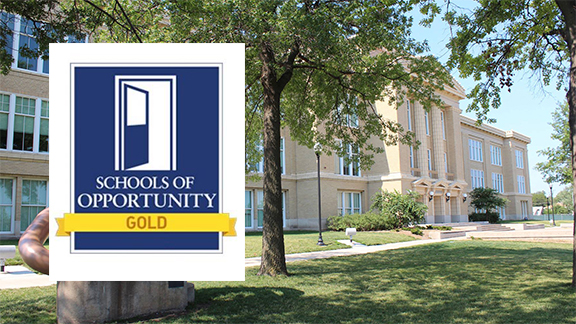
TLTE grad students and professor help Lincoln High earn School of Opportunity recognition
23 Jan 2018
When the National Education Policy Center (NEPC) at the University of Colorado Boulder announced this week that Lincoln High School was one of eight new gold level Schools of Opportunity, Ted Hamann and his graduate students in the Department of Teaching, Learning and Teacher Education took some special pride. The TLTE connection played a big role in Lincoln High becoming the first Nebraska school to receive the recognition and just the 45th ever.
“We know we have a lot to be proud of at Lincoln High,” said Principal Mark Larson. “A lot of hardworking teachers, counselors, coaches, parents, volunteers, partners and students do a lot to make sure we’re a welcoming and successful school, both socially and academically. But we didn’t have time to pull someone from their existing work to assemble an application to the Schools of Opportunity. So it was great when Ted suggested he and his students could do that.”
The Schools of Opportunity program celebrates public high schools that narrow opportunity gaps and succeed with diverse student bodies. Acknowledging that standardized test scores are often a better measure of students’ affluence, parent education level, and the stability of enrollment, the School of Opportunity program instead uses 10 other criteria that more closely capture what the school does than who it enrolls. But to demonstrate that a school excels at these criteria requires documentation.
As part of their coursework last spring, Hamann’s graduate students in TEAC 887, “Effecting High School Improvement,” visited Lincoln High to interview a cross-section of administrators, teachers and students. They gathered the details needed to write first drafts of the information that Lincoln High needed to submit for NEPC’s recognition.
“It was important to me that we leave Lincoln High in control of this process,” said Hamann. “They were kind enough to let us visit their building and use their real challenges and complications, as well as their successes, to think about what a 21st century high school does and should do. So we wanted to offer something in exchange for that contribution to our class and our learning. We sent them about 20 pages of their words, their descriptions, and their data, assembled in response to what NEPC was looking for.”
From that extensive start, Lincoln High was able to add a few more pieces, and then Larson submitted the application. After five months of review, Lincoln High received a call from NEPC in October telling them they were finalists, and then in November they hosted a two-person review team that made a day-long visit. This week’s announcement was rewarding for Hamann and his students.
“It’s rare to get an opportunity to see class concepts being put into practice in real time,” reflected TLTE doctoral student Tony Fucci. “Visiting Lincoln High helped us to frame our discussions around effecting high school improvement in terms of real people, at a real school, trying to make things better for their students. I was impressed by Lincoln High’s knowledge of current research in education, as well as their sincere effort to put what they learned into practice. Most importantly, LHS saw improvement as an endless process and continues to work toward becoming a better, more equitable place for all their students.”
Another TLTE doctoral student, Jillian Harpster, is an English teacher at Lincoln’s North Star High School. “Working with Dr. Hamann and Lincoln High's faculty throughout the writing process made our coursework more tangible, more real,” she said. “Not only did we get hands-on experience writing a proposal like this, but we were able to go into a school, see the changes they have implemented for the betterment of their student body, and consider how programs like CU's could further resource them to continue their diligent work for students. Holistically, it was a really worthwhile, meaningful, and edifying experience.”
Now that it is recognized as a School of Opportunity, Lincoln High will participate in a national network of schools celebrated for their concurrent embrace of diversity and excellence. In turn, Dr. Hamann, notes, “I’m sure we’ll do more with Lincoln High. But this well-deserved recognition has me thinking, maybe it’s time to look at some of the other schools in Lincoln, Omaha, or maybe even Crete or Schuyler—other places with diverse enrollments and strong programs. Maybe we can play a small role in helping their work and successes be recognized, too. In the meantime, ‘Go Links!’”
Additional coverage of Lincoln High’s recognition can be found at these sources:
National Education Policy Center
College of Education and Human Sciences
Teaching, Learning & Teacher Education